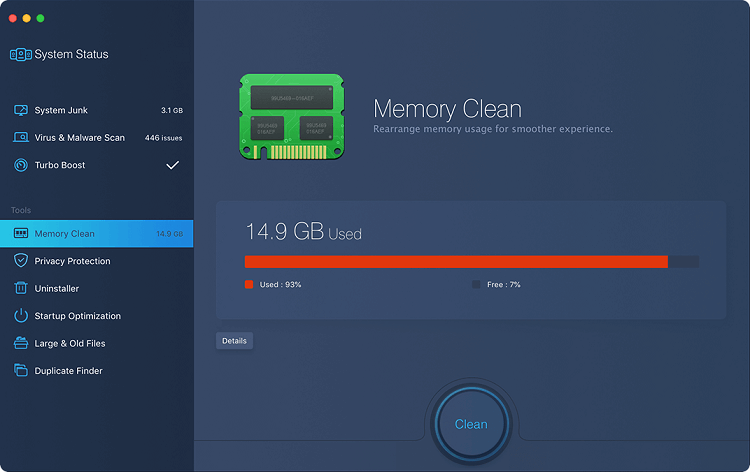

- #Disk aid vs cleanmymac how to
- #Disk aid vs cleanmymac windows 10
- #Disk aid vs cleanmymac software
- #Disk aid vs cleanmymac license
- #Disk aid vs cleanmymac free
Then, press and hold the Option key and choose Library. Alternately, head over to Finder -> Go.Note that in the older versions of MacOS, you will have to first click Library/Logs to access the Diagnostics Reports folder. After that, select the most recent crash report.From the left sidebar, click on Diagnostic Reports.Simply, bring up the Spotlight Search on your Mac (Command+Space) -> type in Console, and launch it.Well, you can use the built-in Console app to check the Kernel log on your Mac. Wondering where you can find the Kernel Panic log on your Mac? Having taken each possibility into the account, we have discussed all the possible ways and means to sort out the Mac Kernel Panic error seamlessly. Things like corrupt files, ill-functioning peripherals, cluttered storage, and insufficient RAM could be playing spoilsport. Though whenever the Mac restarts after a Kernel Panic, a Kernel log is created and added to the log files. At times, the panic is generated and your Mac restarts on its own. It’s worth pointing out that Kernel Panic will not always leave your Mac on a dark grey screen. Hold down the Power button for several seconds or press the Restart button.” When your Mac is in the grip of Kernal Panic, you will see a dark grey screen saying “You need to restart your computer. And when the Mac fails to handle the issue, Kernal Panic occurs on Mac, which leads to unexpected restarts. What makes this component so important is the ability to control several critical things including memory, CPU, and more.Īs a result, when it stops functioning properly, Mac’s performance is drastically hampered. To be more precise, Kernel Panic is a vital component of MacOS – Apple’s operating system for Mac. What is a Kernel Panic and Why it Occurs on Mac?
#Disk aid vs cleanmymac how to
On this note, follow along to learn all about what the Kernel Panic on Mac is about and how to fix Mac keeps restarting issue. But fret not, this is where we come into action.

Thankfully, there is nothing new about the Kernal Panic on Mac. This unexpected boot loop not only throws your ongoing work on the back burner but also causes data loss. You are in the middle of some serious work, and suddenly an error known as Kernel Panic occurs, crashing your Mac out of nowhere. This lets you quickly get an idea of what is taking up the most space on your Mac.Īs with DaisyDisk, you can easily open or move files to the Trash right from OmniDiskSweeper.Believe me, nothing feels more frustrating than finding that your Mac is stuck in a boot loop. Then you’ll see a simple, easily scannable list that shows files from largest to smallest. Open OmniDiskSweeper, and it will scan your drive.
#Disk aid vs cleanmymac free
OmniDiskSweeper, on the other hand, isn’t just simple, but free as well. All of these apps are big, complicated, and fairly pricey.
#Disk aid vs cleanmymac software
OmniGroup is known for its software like OmniFocus, OmniOutliner, and OmniPlan.
#Disk aid vs cleanmymac license
You can try CleanMyMac X with a free trial, but a license for the app will cost you $34.95.Īlso read: How to Check and Manage Disk Space in Linux OmniDiskSweeper


The app can automatically remove outdated caches, broken downloads, logs, and other files you don’t use.ĬleanMyMac X also has a built-in Uninstaller that can help you remove apps along with the various files they usually leave on your system after you delete them. Then it can do a lot more than showing you files you can delete. Run the app, and like the others on this list it will start off by analyzing your drive. Part of the reason behind this is the app’s ease of use, but a large part is also due to just how pretty it looks.
#Disk aid vs cleanmymac windows 10
Instead, it just shows you the size of your Documents directory.Īlso read: 4 of the Best Tools to Analyse Disk Space on Windows 10 DaisyDiskĭaisyDisk is one of the most widely used storage management apps for macOS. For example, Documents doesn’t determine how much space is used by certain file types. Click on a category like Applications, and you’ll see how much space certain apps are using. In the menu on the left, you’ll see various categories. To see how much space is being used by apps, photos, and other categories, you can use the Disk Storage Summary.Ĭlick the Apple icon in the upper left part of the screen, then “About This Mac.” Here, click the Storage tab, then click on Manage. There are a few tools to help you manage disk space built into macOS. Depending on what you’re trying to search, there are a fair number of tools that may solve your problem. Actually figuring out what is taking up the most space isn’t as easy as you might think.


 0 kommentar(er)
0 kommentar(er)
